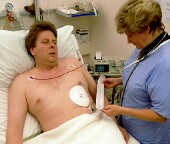
MONDAY, July 11 (HealthDay News) — Cooling cardiac arrest patients can reduce the risk of lasting neurological damage, but this lifesaving treatment remains largely underutilized, a new study says.
Many local hospitals don’t have the proper systems in place, and the cooling treatment must start within hours of a cardiac arrest to be effective, according to the report in the July 11 online issue of Circulation, but rapid transfer to an appropriate facility can save lives and stave off lasting neurological damage.
About 300,000 cardiac arrests occur outside of hospitals in the United States each year, and most are fatal, according to the American Heart Association. Cardiac arrest occurs when the heart’s electrical system short- circuits, and the heart suddenly stops pumping. What happens immediately after the arrest can make a big difference in outcomes. CPR must be performed and a defibrillator should be used to shock the heart and restore a normal heart rhythm within a few minutes, and then the patient must be packed in ice and transferred to a hospital for cooling and re-warming.
Cooling involves lowering the core body temperature to about 92 degrees Fahrenheit and keeping it there for 24 hours. The patient is re-warmed over the next eight hours. The thinking is that cooling may allow the body and the brain to get by with less oxygen.
The system detailed in the new study involves “rapid and coordinated” transfer of the patient to a facility that has appropriate systems in place. Developed at the Minneapolis Heart Institute of Abbott Northwestern Hospital, the system involves first responders, Emergency Medical Service (EMS) departments and more than 30 hospitals within 200 miles of Minneapolis, which is where Abbott is located.
Of 140 people treated with cooling after cardiac arrest, 107 were transferred to Abbott Northwestern Hospital for their treatment. The others were sent to this hospital immediately. Overall, 56 percent of patients who were cooled survived. Survival rates were the same among those who were transferred and those who received initial care at the treating hospital. Risk of death increased by 20 percent for every hour of delay in starting cooling.
Among survivors, 92 percent showed no sign of severe neurological disability, compared to 77 percent of similar patients treated prior to use of the new system. Patients had an average age of 62, and 77 percent were men. The older patients had greater risk for neurological damage, the study showed.
“People don’t just arrest near large centers, but it’s not hard to implement this program,” said study co-author Barbara Unger, director of cardiovascular emergency program development for the Minneapolis Heart Institute.
“If a patient does not regain consciousness after cardiac arrest, you do an EKG to see if they also had a severe form of heart attack [ST-elevation myocardial infarction], and then you may pack them in ice,” she said. “The patient is then transferred to a large tertiary center because you need a wide variety of specialists, including cardiologists, neurologists, emergency room doctors and critical-care nurses on board.”
About half of all patients who received the cooling treatment were also being treated for ST-elevation myocardial infarction, she said.
Saving lives after cardiac arrest starts even before EMS arrives, Unger said. “Bystanders need to perform CPR and use a defibrillator to deliver an electric shock to the heart,” she said. “We have great outcomes waiting for them, but they have to start it.”
“Hypothermia is a very powerful treatment, but it has been a very slow process getting hospitals on board,” explained Dr. Benjamin Abella, an assistant professor of emergency medicine and director of clinical research in the Perelman School of Medicine Center for Resuscitation Science at the University of Pennsylvania Medical Center in Philadelphia.
“Hypothermia is a complicated, multi-disciplinary treatment modality, and you need a protocol,” he said. “One of the big challenges is getting different cultures, such as neurologists, emergency room doctors, cardiologists and nurses, working together.”
One feasible option is to transport these individuals to a regional hospital, he said. “This may be the way forward,” he said. “The new study is an excellent example of a highly functional system.”
More information
For more on cardiac arrest, visit the American Heart Association.

